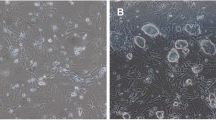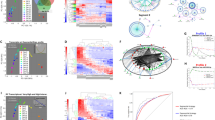Abstract
MicroRNAs (miRNAs) are small non-coding RNA molecules that participate in transcriptional and post-transcriptional regulation of gene expression. miRNAs have numerous roles in cellular function including embryonic development. Human embryonic stem cells (hESCs) are capable of self-renewal and can differentiate into most of cell types including cardiomyocytes (CMs). These characteristics of hESCs make them considered as an important model for studying human embryonic development and tissue specific differentiation. In this study, we tried to demonstrate the profile of miRNA expression in cardiac differentiation from hESCs. To induce differentiation, we differentiated hESCs into CMs by direct differentiation method and characterized differentiated cells. To analyze the expression of miRNAs, we distinguished (days 4, 8, 12, 16, 20, 24, 28) and isolated RNAs from each differentiation stage. miRNA specific RT-qPCR was performed and the expression profile of miR-1, -30d, -133a, -143, -145, -378a, -499a was evaluated. The expression of all miRs was up-regulated at day 8. miR-143 and -145 expression was also up-regulated at the later stage of differentiation. Only miR-378a expression returned to undifferentiated hESC levels at the other stages of differentiation. In conclusion, we elucidated the expression profile of miRNAs during differentiation into cardiomyocytes from hESCs. Our findings demonstrate the expression of miRNAs was stage-dependent during differentiation and suggest that the differentiation into CMs can be regulated by miRNAs through direct or indirect pathway.







Similar content being viewed by others
References
Oh SK, Kim HS, Ahn HJ, Seol HW, Kim YY, et al. Derivation and characterization of new human embryonic stem cell lines: SNUhES1, SNUhES2, and SNUhES3. Stem Cells. 2005;23:211–9.
Kim YY, Ku SY, Huh Y, Liu HC, Kim SH, et al. Anti-aging effects of vitamin C on human pluripotent stem cell-derived cardiomyocytes. Age. 2013;35:1545–57.
Kim YY, Ku JB, Liu HC, Ku SY, Kim SH, et al. Ginsenosides may enhance the functionality of human embryonic stem cell-derived cardiomyocytes in vitro. Reprod Sci. 2014;21:1312–8.
Kim YY, Ku SY, Jang J, Oh SK, Kim HS, et al. Use of long-term cultured embryoid bodies may enhance cardiomyocyte differentiation by BMP2. Yonsei Med J. 2008;49:819–27.
Kim YY, Ku SY, Liu HC, Cho HJ, Oh SK, et al. Cryopreservation of human embryonic stem cells derived-cardiomyocytes induced by BMP2 in serum-free condition. Reprod Sci. 2011;18:252–60.
Kim YY, Ku SY, Rosenwaks Z, Liu HC, Oh SK, et al. Red ginseng extract facilitates the early differentiation of human embryonic stem cells into mesendoderm lineage. Evid Based Complement Alternat Med 2011. doi:10.1155/2011/167376.
Adam AA, Takahashi Y, Katagiri S, Nagano M. In vitro culture of mouse preantral follicles using membrane inserts and developmental competence of in vitro ovulated oocytes. J Reprod Dev. 2004;50:579–86.
Kim YY, Ku SY, Kim YJ, Cho MS, Oh SK, et al. Effects of mycoplasma elimination agent on maintenance and cardiogenic potentials of human embryonic stem cells. Tissue Eng Regen Med. 2010;7:419–24.
Li Y, Du W, Zhao R, Hu J, Li H, et al. New insights into epigenetic modifications in heart failure. Front Biosci (Landmark Ed). 2017;22:230–47.
Kim YJ, Ku SY, Rosenwaks Z, Liu HC, Chi SW, et al. MicroRNA expression profiles are altered by gonadotropins and vitamin C status during in vitro follicular growth. Reprod Sci. 2010;17:1081–9.
Kim YJ, Ku SY, Kim YY, Liu HC, Chi SW, et al. MicroRNAs transfected into granulosa cells may regulate oocyte meiotic competence during in vitro maturation of mouse follicles. Hum Reprod. 2013;28:3050–61.
Kim YJ, Ku SY, Kim YY, Suh CS, Kim SH, et al. MicroRNA profile of granulosa cells after ovarian stimulation differs according to maturity of retrieved oocytes. Geburtshilfe Frauenheilkd. 2016;76:704–8.
Ambros V, Lee RC. Identification of microRNAs and other tiny noncoding RNAs by cDNA cloning. Methods Mol Biol. 2004;265:131–58.
Bartel DP. MicroRNAs: genomics, biogenesis, mechanism, and function. Cell. 2004;116:281–97.
Bartel DP. MicroRNAs: target recognition and regulatory functions. Cell. 2009;136:215–33.
Mallanna SK, Rizzino A. Emerging roles of microRNAs in the control of embryonic stem cells and the generation of induced pluripotent stem cells. Dev Biol. 2010;344:16–25.
Zhao Y, Srivastava D. A developmental view of microRNA function. Trends Biochem Sci. 2007;32:189–97.
Ivey KN, Muth A, Arnold J, King FW, Yeh RF, et al. MicroRNA regulation of cell lineages in mouse and human embryonic stem cells. Cell Stem Cell. 2008;2:219–29.
Wilson KD, Hu S, Venkatasubrahmanyam S, Fu JD, Sun N, et al. Dynamic microRNA expression programs during cardiac differentiation of human embryonic stem cells: role for miR-499. Circ Cardiovasc Genet. 2010;3:426–35.
Takaya T, Ono K, Kawamura T, Takanabe R, Kaichi S, et al. MicroRNA-1 and MicroRNA-133 in spontaneous myocardial differentiation of mouse embryonic stem cells. Circ J. 2009;73:1492–7.
Li Q, Song XW, Zou J, Wang GK, Kremneva E, et al. Attenuation of microRNA-1 derepresses the cytoskeleton regulatory protein twinfilin-1 to provoke cardiac hypertrophy. J Cell Sci. 2010;123:2444–52.
Wang H, Cai J. The role of microRNAs in heart failure. Biochim Biophys Acta. 2016;S0925–4439(16):30328–3.
Krichevsky AM. MicroRNA profiling: from dark matter to white matter, or identifying new players in neurobiology. Sci World J. 2007;7:155–66.
Schickel R, Boyerinas B, Park SM, Peter ME. MicroRNAs: key players in the immune system, differentiation, tumorigenesis and cell death. Oncogene. 2008;27:5959–74.
Mendell JT. miRiad roles for the miR-17-92 cluster in development and disease. Cell. 2008;133:217–22.
He L, He X, Lim LP, de Stanchina E, Xuan Z, et al. A microRNA component of the p53 tumour suppressor network. Nature. 2007;447:1130–4.
Oh SK, Kim HS, Park YB, Seol HW, Kim YY, et al. Methods for expansion of human embryonic stem cells. Stem Cells. 2005;23:605–9.
Sluijter JP, van Mil A, van Vliet P, Metz CH, Liu J, et al. MicroRNA-1 and -499 regulate differentiation and proliferation in human-derived cardiomyocyte progenitor cells. Arterioscler Thromb Vasc Biol. 2010;30:859–68.
Cordes KR, Srivastava D. MicroRNA regulation of cardiovascular development. Circ Res. 2009;104:724–32.
Shradhanjali A, Riehl BD, Kwon IK, Lim JY. Cardiomyocyte stretching for regenerative medicine and hypertrophy study. Tissue Eng Regen Med. 2015;12:398–409.
Hotchkiss A, Feridooni T, Zhang F, Pasumarthi KB. The effects of calcium channel blockade on proliferation and differentiation of cardiac progenitor cells. Cell Calcium. 2014;55:238–51.
Chistiakov DA, Orekhov AN, Bobryshev YV. Cardiac-specific miRNA in cardiogenesis, heart function, and cardiac pathology (with focus on myocardial infarction). J Mol Cell Cardiol. 2016;94:107–21.
Greulich F, Rudat C, Kispert A. Mechanisms of T-box gene function in the developing heart. Cardiovasc Res. 2011;91:212–22.
Wang YS, Li SH, Guo J, Mihic A, Wu J, et al. Role of miR-145 in cardiac myofibroblast differentiation. J Mol Cell Cardiol. 2014;66:94–105.
de la Pompa JL, Epstein JA. Coordinating tissue interactions: Notch signaling in cardiac development and disease. Dev Cell. 2012;22:244–54.
Kim YY, Kim H, Ku S, Suk CS, Kim SH, et al. Effects of estrogen on intracellular calcium-related T-lymphocyte function. Tissue Eng Regen Med. 2016;13:270–3.
Kim YY, Kim YJ, Cho KM, Kim SH, Park KE, et al. The expression profile of angiotensin system on thawed murine ovaries. Tissue Eng Regen Med. 2016;13:724–32.
Acknowledgements
This study was supported by grants of Ministry of Science, ICT and Future Planning (2014R1A1A305264 and 2016R1E1A1A01943455). The authors would like to express sincere thanks to the technical assistance of Kyung Mee Cho and Mi Ae Lee.
Author information
Authors and Affiliations
Corresponding author
Ethics declarations
Conflict of interest
The authors have no conflicts of interest.
Ethical statement
The study was approved by the IRB of the IRMP, MRC, Seoul National University (219932-201412-LR-12-01-01).
Electronic supplementary material
Below is the link to the electronic supplementary material.
Supplementary movie. Representative beating cluster of cardiomyocytes differentiated from human embryonic stem cells (MPG 5067 kb)
Rights and permissions
About this article
Cite this article
Kim, Y.Y., Min, H., Kim, H. et al. Differential MicroRNA Expression Profile of Human Embryonic Stem Cell-Derived Cardiac Lineage Cells. Tissue Eng Regen Med 14, 163–169 (2017). https://doi.org/10.1007/s13770-017-0051-4
Received:
Revised:
Accepted:
Published:
Issue Date:
DOI: https://doi.org/10.1007/s13770-017-0051-4




